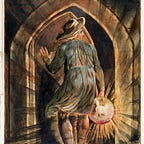We all need more beauty in our lives
“The recognition of beauty in works of art does not come directly. It reveals itself at various oblique angles. It takes time to absorb.” — Robert C. Morgan Ph.D.
James Elkins, Art critic and historian at the School of the Art Institute of Chicago, has found Giovanni Bellini’s Ecstasy of St. Francis to be “the most beautiful painting in the world”. According to Dr. Elkins, the painting “reveals itself at various oblique angles”.
Elkins explains how “even the gatherings of fabric in the waistband of St. Francis are echoed in the tendrils of ivy spreading from a fissure in the rock above.”
Art often involves finding something delightful when you’re not looking for it. Steven Gambardella suggests eight ways to find something delightful while looking at a painting
- Overall size and shape — the picture doesn’t require much movement from the viewer; you can stand in the same spot and take it all in.
- Shapes within the image — Some broad shapes in the picture can be spotted if you look at how the elements are clustered.
- Color tones — a division between the cooler blues and greens of the sky, trees, and other greenery and the warmer colors of earth and flesh
- Intended movement — Painters, sculptors, and other artists often try to make your eye move around their artwork. They do this using the composition and the way the parts of the piece interact.
- Style — realism vs. mythology, etc.
- Theme — A painting alone isn’t going to tell you the whole story of what is happening. To fully appreciate a painting you’ll need to do some reading or listen to a gallery educator talk about it.
- Allusions — For example the general influence of ancient Greek and Roman art on artwork during the Renaissance is indisputable.
- Cultural meaning — Renaissance painting styles were notable for their anatomical accuracy, influence by Greco-Roman sculptures, vivid color (thanks to the invention of oil paint), and linear perspective.
Two Sisters (On the Terrace) created by Pierre-Auguste Renoir, pictured here, is one of the most well known paintings in the world. It captures all of Gambardella’s eight elements of delightfulness.
Originally titled Two Sisters, the painting was given the additional title of “On the Terrace” by an art dealer who owned the painting for a brief period of time.
Renoir painted his masterpiece in Chatou, a suburb of Paris where he spent much of his time. The background was inspired by the wooden banks of the River Seine in that area.
He painted the piece at Maison Fournaise, which is where he created other pieces earlier. It’s believed to have been created in 1881. Actress Jeanne Darlot was revealed to be the older sister in the painting, while the younger sister is unidentified.
The artist used oil on canvas to make this 100.5 x 81 cm painting. The two young girls are wearing beautiful hats with long dresses. There are sparse trees in the background surrounding the river when the sun appears to be diminishing.
Renoir began work on the painting in April 1881 and on July 7, of that year, it was bought by the art dealer, Paul Durand-Ruel, for 1,500 francs. The painting was presented for the first time to the public at the 7th Impressionist exhibition in the spring of 1882. In 1883 it was known to be in the collection of Charles Ephrussi, an art collector and publisher, but in 1892 the painting was returned again to the collection of the Durand-Ruel family.
In 1925, the painting was sold to Annie Swan Coburn from Chicago for $100,000. After her death in 1932 the painting was bequeathed to the Art Institute of Chicago, where it has remained since 1933.
The rule of thirds is a composition guide that calls for arranging the important features of an image on or near the horizontal and vertical lines that divide the image into thirds horizontally and vertically which makes a painting visually pleasing. The objective is to stop the subject(s) and areas of interest (such as the beautiful girls) from bisecting the image, by placing them near one of the lines that would divide the image into three equal columns and rows, ideally near the intersection of those lines. As see here Renoir applies this rule of composition perfectly, bringing all of the elements of delightfulness together in his masterpiece, which has always brought great delight and beauty into my life as I hope it does to yours.
Beauty can be found in more than painting. It can also be found in music, especially the music of Alma Deutscher.
